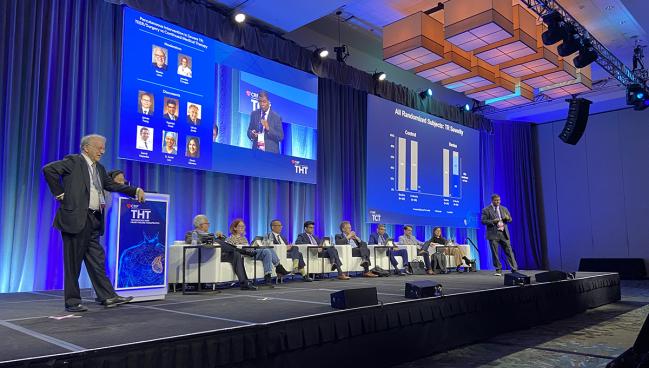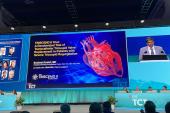Debating the Role of T-TEER in the Sickest Patients
T-TEER is poised for FDA clearance following a positive review, but experts say roles remain for medical, or even palliative, care.

Boston, MA—When it comes to choosing between transcatheter edge-to-edge repair (TEER) or guideline-directed medical therapy for tricuspid regurgitation (TR) for the most severely ill patients, the various specialists involved in the discussion may face an uphill battle in reaching consensus on care.
That point was hammered home Monday at the THT 2024 meeting in Boston, MA, where two prominent cardiologists debated the best treatment strategy for an 82-year-old patient with severe tricuspid regurgitation and NYHA class III heart failure (HF) with preserved ejection fraction. This single case exemplified the tricky decision-making required of physicians caring for HF patients with TR, particularly in light of new devices expected to be available soon in the United States.
In one corner, Milton Packer, MD (Baylor University Medical Center, Dallas, TX), a renowned HF specialist, made the case for continued—and comprehensive—medical therapy. In the other, Saibal Kar, MD (Los Robles Regional Medical Center, Thousand Oaks, CA), a preeminent structural interventionist, sang the praises of tricuspid TEER (T-TEER).
Kar pointed out that, in addition to functional TR, the patient had annular dilatation due to chronic atrial fibrillation (AF), extremely limited exercise tolerance, and evidence of right ventricular dysfunction, not to mention various comorbidities, including type 2 diabetes and liver cirrhosis. For those reasons, said Kar, TEER would be the better “solution” for the patient. And, at the outset of the debate, the majority of the THT audience agreed with him, voting almost 3 to 1 in favor of T-TEER instead of relying solely on medical therapy.
“The patient is extremely high risk for surgery, especially with RV dysfunction and cirrhosis,” said Kar. “The only option is transcatheter repair, replacement, or hospice.” Transcatheter tricuspid valve replacement would abolish TR, but with moderate RV dysfunction, the patient could go into acute RV failure, said Kar. They also wouldn’t be able to take anticoagulation because of the liver cirrhosis.
In this particular case, 6 months after the patient had been admitted to hospital for acute congested HF, medical therapy had been maxed out. It included dapagliflozin 10 mg once per day, spironolactone 50 mg twice per day, torsemide 60 mg twice per day, as well as metolazone 2.5 mg, digoxin 125 mg, metoprolol 12.5 mg, and warfarin 10 mg all once daily. Even so, said Kar, the patient continued to be short of breath when walking less than two blocks, even less if there was an uphill gradient.
“The next option, the safest and most humane option, would be transcatheter edge-to-edge repair using TriClip or the Pascal system, although at present neither is approved in the US so they would [have to be] in a study,” he said.
Packer, on the other hand, strongly disagreed. “I think it's absolutely great that most people [at THT 2024], when they see a leak, want to fix it,” said Packer. “But what this patient really needs is a doctor.”
Based on the pulmonary vascular resistance and wedge pressures, Packer stressed that the patient should be diagnosed with pulmonary arterial hypertension (PAH), which shouldn’t be surprising as 10% to 15% of people with alcoholic cirrhosis have PAH.
“This patient needs a PDE5 inhibitor, a drug like sildenafil, which will treat the pulmonary hypertension and, by the way, reduce the hepatic venous pressures and markedly improve the hemodynamics in the liver,” he advised.
Soft Endpoint in an Open-Label Trial
While the debate focused on a single case, it was really a stand-in for the emerging role of T-TEER in light of the positive TRILUMINATE trial. In that study, the hierarchical composite endpoint of all-cause mortality or tricuspid valve surgery, hospitalization for HF, and improvement in quality of life based on the Kansas City Cardiomyopathy Questionnaire (KCCQ) favored TEER over medical therapy at 1 year (win ratio 1.48; 95% CI 1.06-2.13). As Packer pointed out, the benefit was driven by improvements in quality of life.
Just last month, a US Food and Drug Administration advisory committee voted overwhelmingly in support of the safety and efficacy of T-TEER. While the FDA doesn’t have to follow the directions of the advisory committee, it usually does take their advice.
In addition to the benefits seen in the randomized trial, Kar noted there are registry data and real-world clinical experience supporting TEER. In the randomized cohort, 88% had at least a reduction in TR severity to moderate, a benefit that was also seen in the single-arm study where patients had more-severe disease. Additionally, when the randomized trial data were combined with patients who were part of the roll-in cohort, there was no difference in mortality or tricuspid valve surgery and a slight, nonsignificant reduction in HF admissions at 1 year.
Packer, however, was having none of it. He extensively criticized TRILUMINATE, starting with the decision to perform a “win-ratio” analysis for the study’s primary composite endpoint, which he called an “act of academic desperation.”
“The reason it’s an act of desperation is that success is almost always driven by the least important component,” he said.
Among the 350 patients randomized to treatment, there was no effect on all-cause mortality or tricuspid valve surgery, while hospitalizations for heart failure were more frequent in the group treated with TEER, said Packer. “In fact, take a look at all the other things that came out during the FDA review of TRILUMINATE: more deaths, more cardiovascular mortality, more tricuspid valve interventions, more major bleeding, and more new-onset renal failure [with TEER].”
As for the effect on quality of life, Packer found little solace in the improvement in KCCQ, noting this was an open-label trial and subject to the placebo effect. He likened very sick HF patients with functional TR to a house on fire, with everybody running around trying to do something, anything. Fixing a leaky valve in such a complex patient is a cosmetic fix alone, he said.
We Can Do T-TEER, but Should We?
Jennifer Cowger, MD (Henry Ford Health, Detroit, MI), one of the panelists during the debate, said the decision to go with T-TEER or continue with medical therapy is extremely challenging in the real world.
“There’s an absolute need for multidisciplinary discussion,” she told TCTMD. “Every patient has their own story. So, you know, an 82-year-old patient has a very different story than from a 54-year-old patient. It’s not just about looking at the clinical trials and seeing what the results are. Instead, do the clinical trials apply to that patient, and are there other things about that patient that can make the result either more favorable or potentially less favorable? It’s about looking not just at the data, but to the patient as a whole so we can understand what the best intervention will be.”
I think there is respect in appreciating the dying process. Jennifer Cowger
Another panelist, Kashish Goel, MD (Vanderbilt University Medical Center, Nashville), told TCTMD that he would be inclined to go with TEER in the clinical scenario that kicked off the debate. “I always get worried when people are labeled as having alcoholic cirrhosis,” he said. “Like, is the TR playing a role here as well? My inclination would have been to fix the TR and continue to treat the pulmonary hypertension if that’s what it is.”
Goel pointed out that patients with severe PAH were excluded from TRILUMINATE and TRISCEND II, a tricuspid valve replacement study, and from the ongoing CLASP II study. Such patients, he said, are unlikely to benefit from TEER and in them the procedure might actually cause harm.
“But when you have a patient who has mild-to-moderate RV dysfunction, some pulmonary hypertension, but they're symptomatic, sildenafil may or may or may not work,” he added. “They may become hypotensive, they may not tolerate it. It is very complex decision.”
For Cowger, given the parameters of the patient, her first choice would be to continue with medical therapy to see if they would improve.
“My thinking was not to do TEER,” she said. “They had lots of comorbidities, and I think there is respect in appreciating the dying process. Sometimes, even though patients feel miserable and want everything done, there are cases where that may not be the most just.” Given the age, liver cirrhosis, and severe functional limitations, Cowger questioned whether any benefits of T-TEER would be perceptible, within a year.
During the discussion, James Fang, MD (University of Utah School of Medicine, Salt Lake City), made a similar point.
“This patient's dying,” said Fang. “I think you can do all these things, but an 82-year-old with all these comorbidities, which, over the course of several months despite medical therapy, is declining symptomatically. I think that's elephant in the room. What this patient needs is a palliative care doctor.”
At the end of the debate, the panel was polled again and this time around, Packer had won the audience over, with most voting that continued medical therapy was the preferred option.
Michael O’Riordan is the Managing Editor for TCTMD. He completed his undergraduate degrees at Queen’s University in Kingston, ON, and…
Read Full BioSources
Multiple speakers. Percutaneous intervention in severe TR: TEER/surgery vs continued medical therapy. Presented at: THT 2024. March 4, 2024. Boston, MA.
Disclosures
- Packer reports grant support and research contracts from Abbvie. He reports receiving consulting fees, speaker’s bureau fees, and honoraria from Boehringer Ingelheim, Actavis, Medtronic, 89bio, Altimmune, Alnylam, Ardelyx, Attralus, Biopeutics, Caladrius, Casana, CSL Behring, Imara, Lilly, Moderna, Novartis, Pharmacosmos, Reata, Regeneron, and Salamandra.
- Kar reports consulting fees, speaker’s bureau fees, and honoraria from Boston Scientific, Abbott Vascular, and W.L. Gore. He reports grant support/research contracts from Abbott Vascular, Boston Scientific, Edwards Lifesciences, Medtronic, and HiLife. He is a member of the scientific advisory board for InterShunt Technologies.
- Cowger reports consulting fees, speaker’s bureau fees, and honoraria from Abbott, Endotronix, Medtronic, CorWave, CH Medical, and Zoll. She has equity/stocks with Procyrion.
- Goel reports consulting fees, speaker’s bureau fees, and honoraria from Edwards Lifesciences.





Comments